Day 2 of a three day Autumn Tour today. It was forecast to be cool and showery today, with the possibility of some more organised and heavier rain around the middle of the day. As it was, we saw very little rain and even some brighter intervals.
With the possibility that there might be some autumn migrants from the continent today, we stopped at Warham Greens first on our way east along the coast road. As we walked down the track, we could hear a Chiffchaff singing in the hedge.
Some of the fields here are edged with strips of wild bird seed mix and we stopped to look down one of the strips which ran down alongside a thick hedge. There were lots of birds which flew up from the vegetation and up into the hedge – Chaffinches first, then several Yellowhammers too, a couple of Dunnocks and a Common Whitethroat. The hedges are very leafy now and it was hard to see the birds in the bushes, but we did eventually get a look at a Yellowhammer perched in the top. There were a couple of Brown Hares running around in the middle of the field too
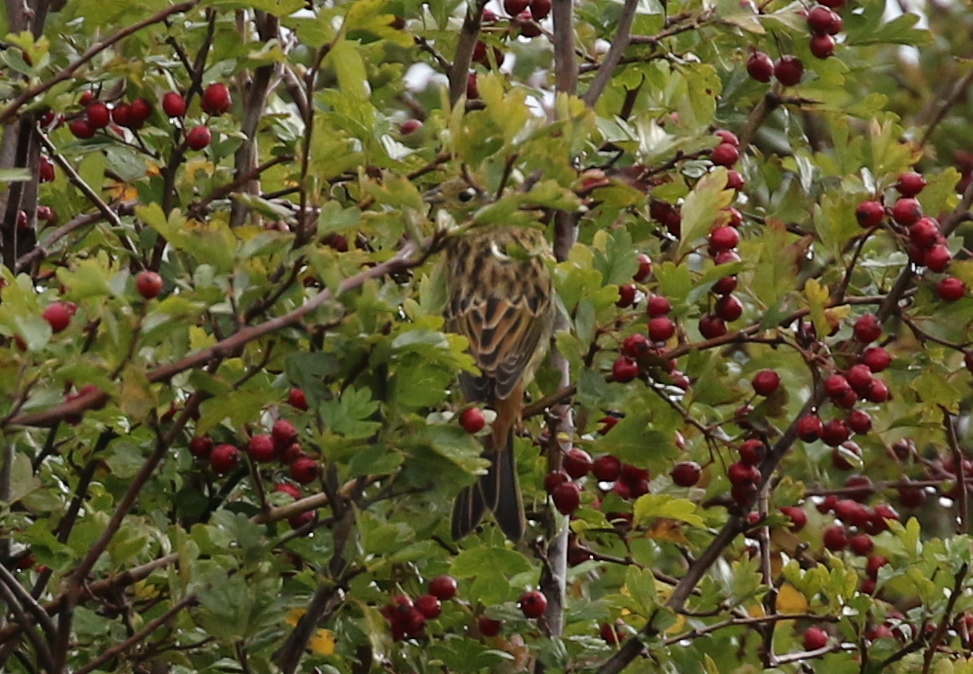 Yellowhammer – hard to see up in the thick hedges
Yellowhammer – hard to see up in the thick hedges
A little further along the track, we heard a Long-tailed Tit calling and soon after we were surrounded by a tit flock. There were Blue Tits and Great Tits too, and at least one Chiffchaff with them, but we couldn’t find anything more unusual.
The old barn had several Stock Doves on its roof and the stubble field beyond held a large gaggle of Canada Geese and a single Curlew. As with yesterday, Pink-footed Geese were a feature particularly of the morning. There were not as many arriving as yesterday, but as we walked down towards the saltmarsh we heard the first of several small skeins which would fly over us today. We could hear their high-pitched yelping calls long before we could see them. They were all heading west, towards Holkham.
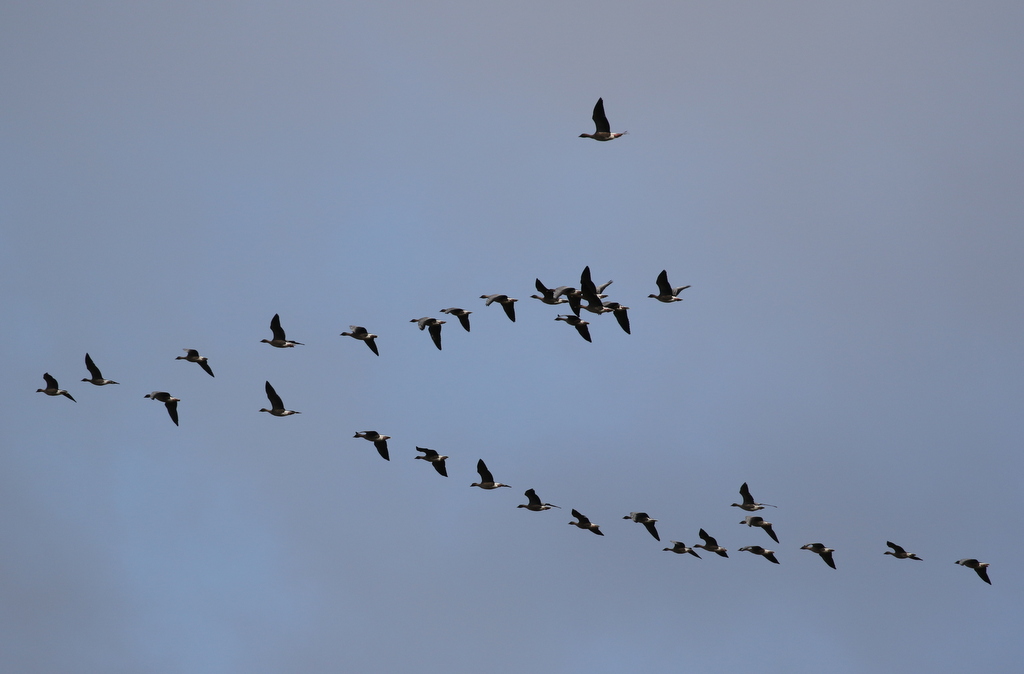 Pink-footed Geese – one of several small skeins to fly over us today
Pink-footed Geese – one of several small skeins to fly over us today
When we got out through the gate at the bottom of the track and out into the open, we stopped to scan the saltmarsh. There were a couple of Little Egrets out there, a few Redshanks and several Curlew. A Marsh Harrier appeared away to the east, flying towards us over the saltmarsh, the first of several we would see hunting out there. It flushed all the waders beneath it as it flew across.
While we were watching the Marsh Harrier, a Peregrine appeared in the same view. It was a juvenile, brown-backed and streaked below. As it raced across over the saltmarsh, it flushed a Redshank, which it turned and stooped at. It missed, banked, climbed and stooped again, the Redshank crashing into a pool to evade it. The Peregrine lost interest in it and had a little tussle with the Marsh Harrier next. All this action was scattering the other birds in all directions, and as the Peregrine started to fly off, a Little Egret flew up beneath it. The Peregrine decided to have a little stoop at that too, it was clearly lacking in experience of what to hunt!
We were still watching the aftermath of all of this when we spotted a Short-eared Owl hunting out over the back of the saltmarsh. It was a little distant, but we got it in the scope and had a good view of it as it quartered over the grass. It landed a couple of times, but came back up again a short while later to resume hunting. Eventually we lost sight of it out over the dune ridge. It was nothing but raptor and owl action for at least 15 minutes!
When the action had died down, we had another scan of the saltmarsh. Way off in the distance we could see several large white blobs and through the scope we could see they were Spoonbills. We had a quick look at them and then started to walk east along the coast path for a closer view. We checked the hedges on the way, but there was no sign of any fresh migrants here, just Goldfinches, Linnets and more tits. A couple of Blackcaps called from the bushes.
When we got to the whirligig, we could see there were five Spoonbills. For once, they were not asleep, but were feeding actively. Despite their size, they were hard to see once the walked down into the saltmarsh pools and put their heads down to feed. From time to time, they would climb out again and we could get a better look at them.
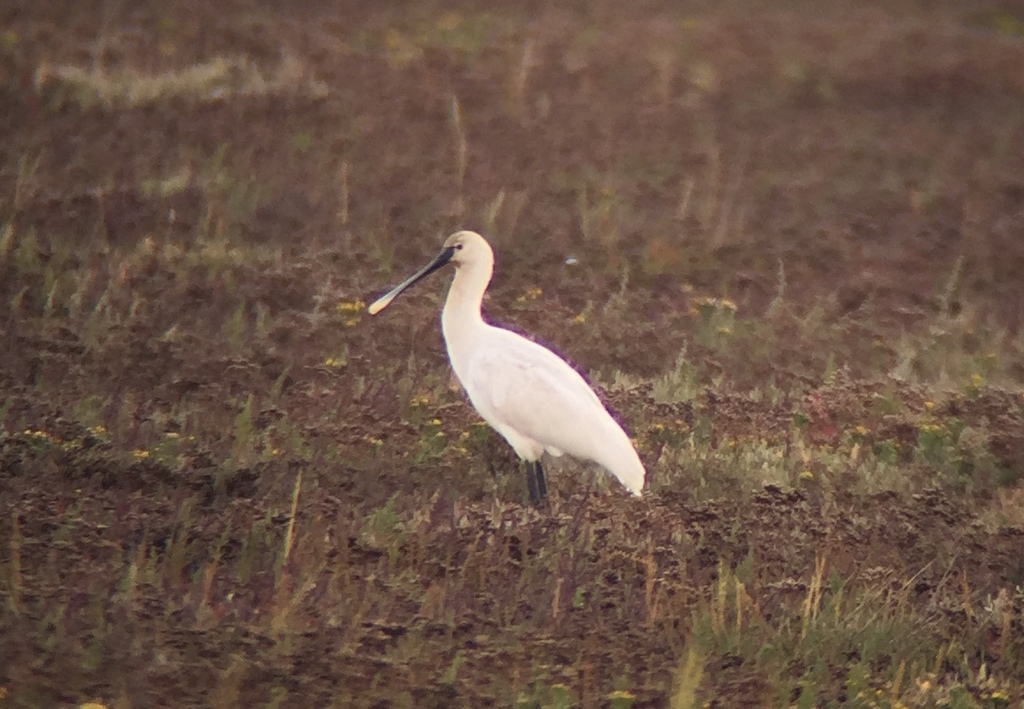 Spoonbill – 1 of 5 out on the saltmarsh today
Spoonbill – 1 of 5 out on the saltmarsh today
There were lots of Golden Plover here today, but they were mostly up in the fields behind us. We had seen a couple of small groups, when suddenly several larger flocks appeared, first one away to the west, then another in from the fields behind us. The latter circled overhead and looked like they might land out on the saltmarsh, but instead flew off west to join the others. There were a couple of Greenshanks feeding out on the saltmarsh too, which flew off calling as we got to the whirligig.
Another Marsh Harrier appeared, slightly to the east of us and again started to flush all the Curlews and Redshanks as it flew towards us over the saltmarsh. The Spoonbills heard the commotion and all came out on the pool they were feeding in, standing upright, looking round. The next thing we knew, four of them were off. They flew up, circled round, and headed off east, presumably to roost at Stiffkey Fen. One Spoonbill was left behind and remained standing where it was while the others took off, looking slightly lonely.
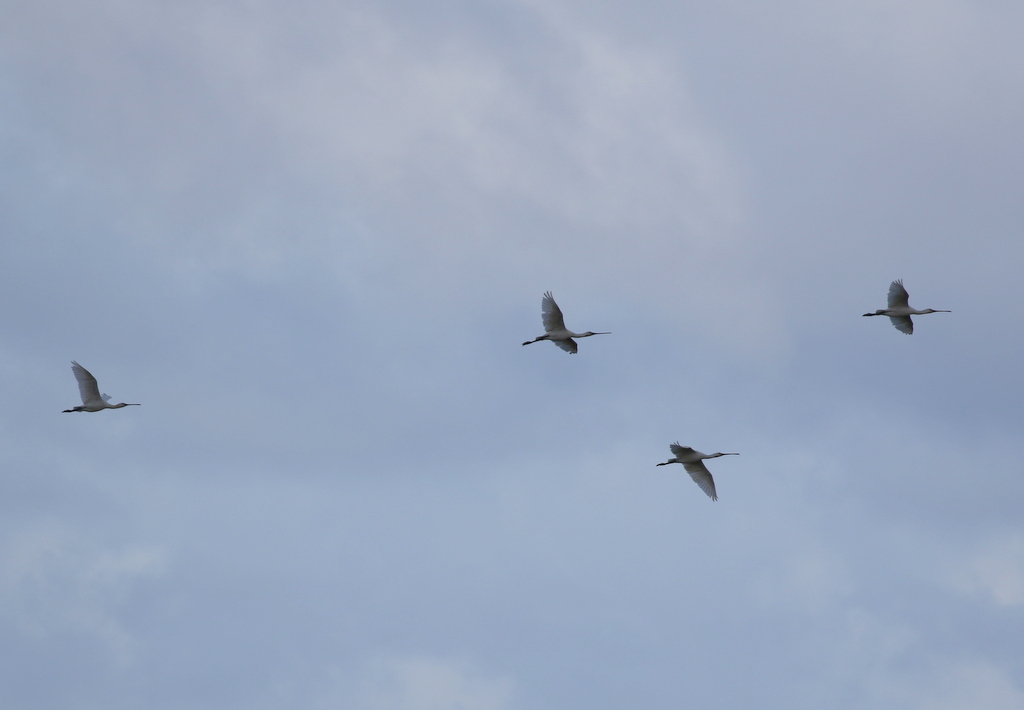 Spoonbills – these four flew off east
Spoonbills – these four flew off east
With the Spoonbills having departed, we decided to make our way back. One of the group had lost a lens cap, so we searched the lane as we walked up the lane, eventually finding it when we were almost back to the car. The tit flock was still in much the same place as it had been earlier this morning, when they were presumably the reason for the dropped lens cap. The birds were coming out into the sunny side of the hedge, so we stopped to watch them. Several of the Long-tailed Tits landed in the bush right in front of us, as they worked their way first one way up the hedge and then back down the other way.
 Long-tailed Tit – in a mixed tit flock along the track this morning
Long-tailed Tit – in a mixed tit flock along the track this morning
While we were watching the tits, a Peregrine appeared in the sky in front of us, flying straight towards us. It was a young one again, heavily streaked below, possibly the same bird we had seen out over the saltmarsh earlier. When it got to the track, it started to circle, right over our heads. Great views! Then it drifted off away over the fields. Photos of the Long-tailed Tits taken as the Peregrine circled over show them looking nervously up towards the sky!
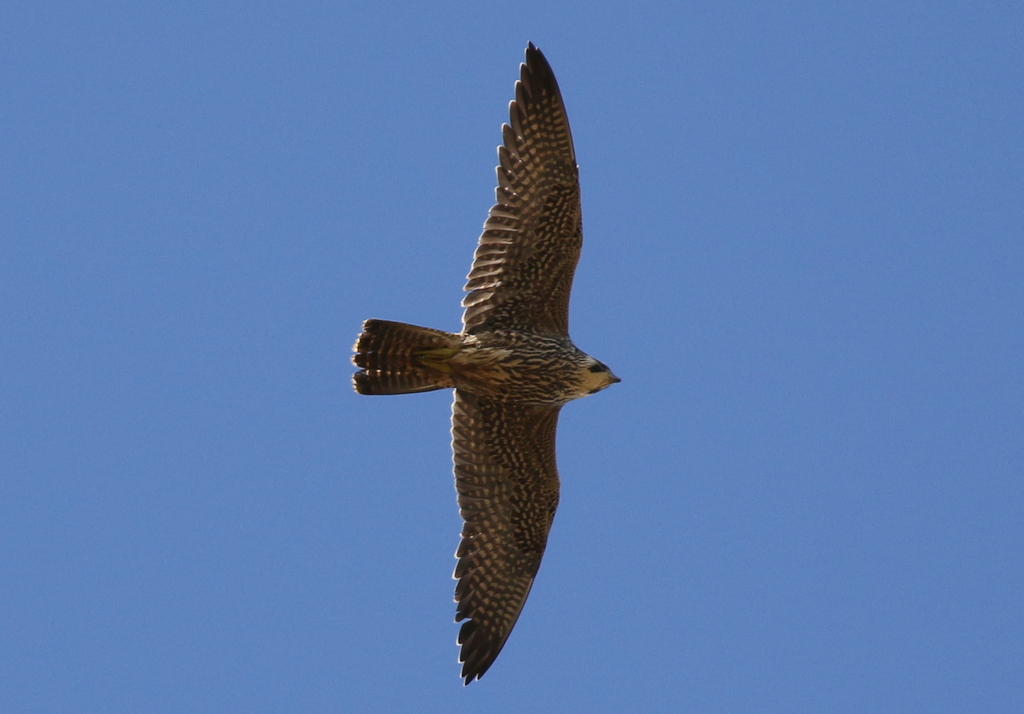 Peregrine – this juvenile circled right over out heads
Peregrine – this juvenile circled right over out heads
Our next destination was Cley. While we had been at Warham, news had come through that there was a Red-necked Phalarope on one of the scrapes. Thankfully we were informed it was still present when we arrived so we headed straight out to Daukes Hide.
The Red-necked Phalarope was towards the back of Simmond’s Scrape at first, running around in the shallow water next to one of the islands, picking at the surface for food. It was a juvenile, mostly white below with a black bandit mask, dark cap and darker back. In good light, it was possible to see a pink tinge to the breast, lacking the red neck patch shown by the adults in summer plumage.
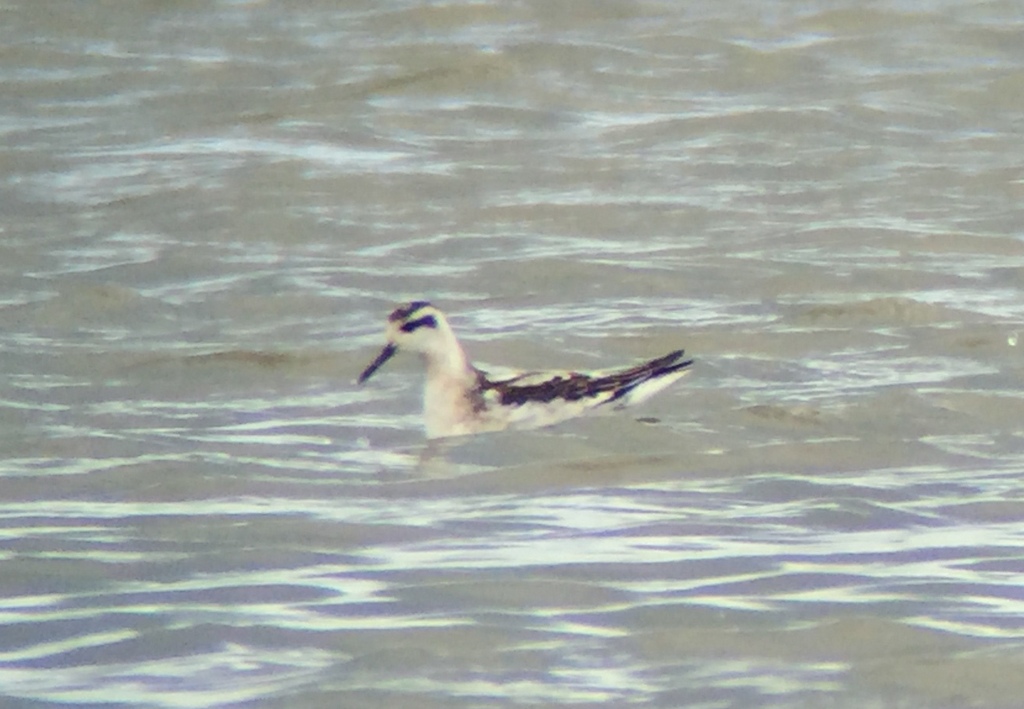 Red-necked Phalarope – a juvenile, at Cley today
Red-necked Phalarope – a juvenile, at Cley today
All the waders were very jumpy today, and kept taking off and flying round, before landing again. The Red-necked Phalarope would join them each time, but kept returning to roughly the same place at first, remaining over the back. Then all the waders flushed again and the Red-necked Phalarope flew off on its own and landed on Pat’s Pool. It started to come closer to us, flying and landing, stopping to preen, then flying and landing again. We thought it might land in front of Teal Hide, but instead flew back to Simmond’s Scrape and landed in the middle, much closer than it had been. The water was deeper here, so it started to swim, spinning round in characteristic fashion, trying to stir up food to the surface where it could pick at it.
Other than the Red-necked Phalarope, there was a nice selection of other waders on here today. There was a small flock of 30 or so Dunlin and in with them were two Little Stints. Next to the Dunlin, we could see just how small the Little Stints were, with a short bill and cleaner, paler underparts. A third Little Stint flew in and joined them.
There were several Ringed Plovers on the grassy islands and a single juvenile Little Ringed Plover still too. A flock of Golden Plover flew in and landed on Pat’s Pool, nice to see them on the ground after seeing them in flight this morning. Through the scope we could see that several still had the remnants of their summer black belly feathering. There were a couple of Ruff and Black-tailed Godwits here too.
When everything flushed yet again, this time there seemed to be more urgency to it and we looked across to see a Hobby streaking low across the scrape, before disappearing away over the reedbed. It went through so quickly, some of the group couldn’t get onto it. But once it had gone, it immediately became clear that many of the waders had gone too. There was no sign of the Red-necked Phalarope now.
We decided to head back for lunch. It had been forecast to rain from 1pm-3pm and roughly on cue it did start to rain. It was just a shower though, and we didn’t have to wait long – after a couple of minutes it cleared through on the brisk wind. It was still spitting a little as we walked back and when we started to eat, but it didn’t amount to much, certainly not what was forecast. A Grey Heron flew in high from the east over lunch, and continued straight on across the reserve. It looked like it was a migrant on its way through.
After lunch, we made our way the short distance along the coast to Kelling. When we got out of the car, we could see a Spitfire flying over the edge of the ridge beyond, part of the 1940s weekend in Holt and Sheringham today. It was pulling some impressive manoeuvres, but was not the sort of bird we were looking for. As we made our way down the lane, a Chiffchaff was calling in the bushes and a Greenfinch flew out. It was sunny now, and there were a few dragonflies and butterflies out – Common Darters, Migrant Hawker and Red Admiral.
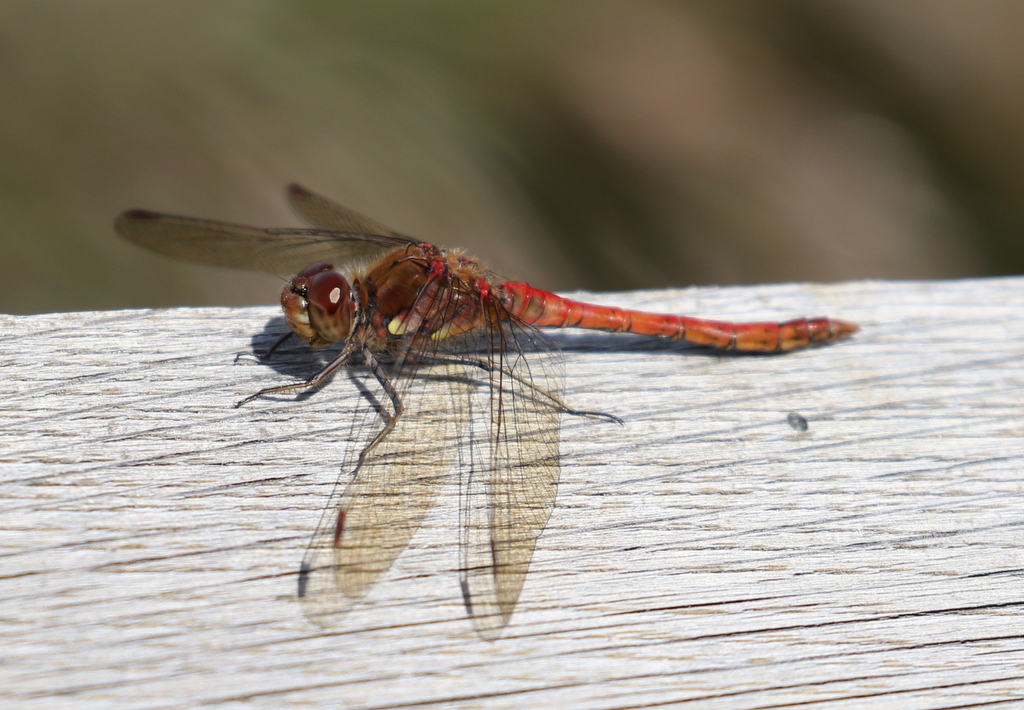 Common Darter – there were several out in the sunnier spots this afternoon
Common Darter – there were several out in the sunnier spots this afternoon
There was no sign of any freshly arrived migrants either in the lane or around the copse, so we continued on to the Water Meadow. It seemed rather quiet at first, just a couple of Ruff and a single Redshank at the top end. There had been a Curlew Sandpiper here earlier, but it wasn’t until we got to the other end that we found the flock of Dunlin and there was the Curlew Sandpiper with them.
It was hard to see the waders over the hedge at first, so we continued on towards the corner and found a large gap where we could set up the scope. Here we had a great view of the Curlew Sandpiper feeding with the Dunlin. The Curlew Sandpiper was a juvenile, clearly slightly larger and longer billed than the Dunlin, and cleaner below with a peachy wash across the breast and white belly.
 Curlew Sandpiper – the juvenile with a Dunlin
Curlew Sandpiper – the juvenile with a Dunlin
Curlew Sandpipers breed in central Siberia and winter in Africa. This one has stopped off on its way to feed up. We get them here every autumn, in variable numbers depending on how successful the breeding season has been.
There had been a couple of Little Stints here too earlier, but we couldn’t see them at first. That was because they were hidden behind the short sedge and reed along the edge of the pool, out of view, until they came out into the open. It was great to see them together with both the Dunlin and Curlew Sandpipers. They were both juveniles as well, on their way from the arctic tundra to the Mediterranean or Africa for the winter.
 Little Stint – one of two at Kelling WM today
Little Stint – one of two at Kelling WM today
A Hobby zipped through in a blur, spooking all the waders, before continuing up over the field beyond. There were some hirundines feeding at the top of the ridge and the Hobby powered towards them and through them, zooming up into the air before turning sharply and plunging back through them. More impressive than the Spitfire we had seen earlier! It disappeared off behind the ridge, but a few minutes later, it or another Hobby made another pass over the Water Meadows.
We wanted to make one more stop before we finished today, so we made our way back up the lane to the car. On the way, three Grey Herons flew high overhead, dropping from the ridge down towards the coast. These looked sure to be migrants, making their way west, further suggesting the one we had seen at lunchtime was on its way too.
There had been a Snow Bunting on the beach at Cley this morning and this was one species that members of the group had asked whether we might see this weekend. They are fairly common here in the winter, not at this time of year normally, but this is an early returnee.
We set off along the beach to look for it. There were quite a lot of people out enjoying the afternoon sunshine and a running race along the coast so every few minutes a runner ran off along the beach. It seemed unlikely the Snow Bunting would still be there. We worked our way carefully along the edge of the vegetation, and suddenly it hopped out in front of us at the top of the beach. It was very close – Snow Buntings can be very tame and this was a young one so had possibly never seen people before. We got the scope on it, even though it wasn’t really necessary, and had frame filling views of it.
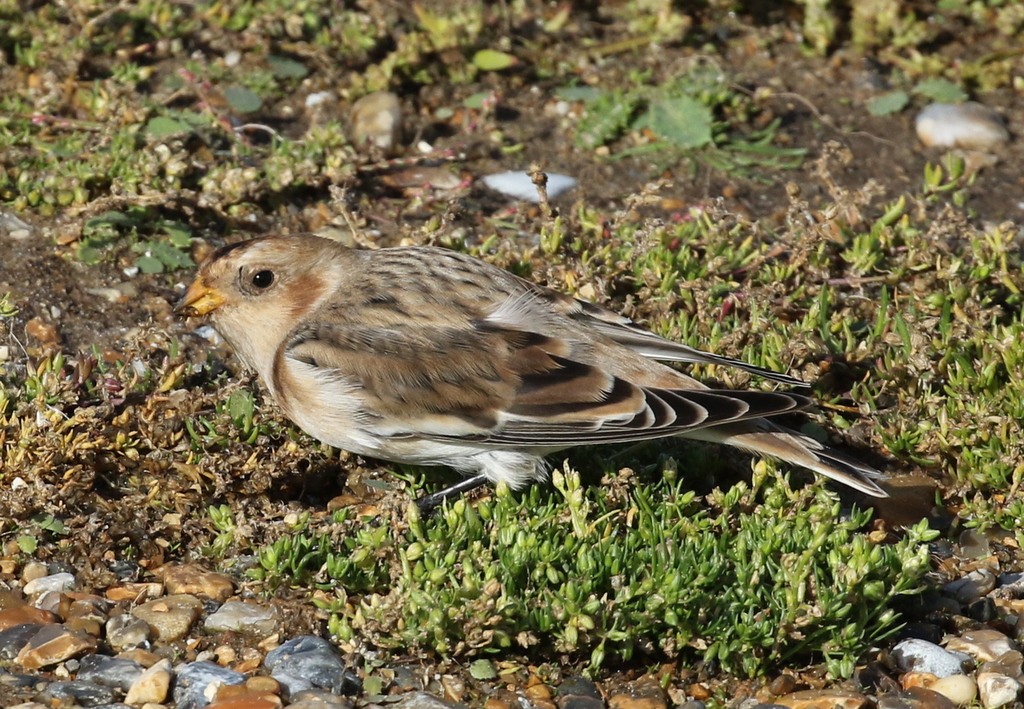 Snow Bunting – feeding on the beach at Cley
Snow Bunting – feeding on the beach at Cley
The Snow Bunting was feeding on the low seedy plants growing in the shingle on the edge of the beach, creeping around on the ground. We had great views of it until one of the runners came along the beach and ran across right in front of us, almost treading on the poor Snow Bunting. At the last minute, the bird hopped back and disappeared down onto the beach. We waited a couple of minutes to see if it would come back but time was getting on so we decided to head back.
The Snow Bunting was a great way to end the day, although we did also manage a couple of Gannets and three Sandwich Terns over the sea as we made our way back to the car.
















